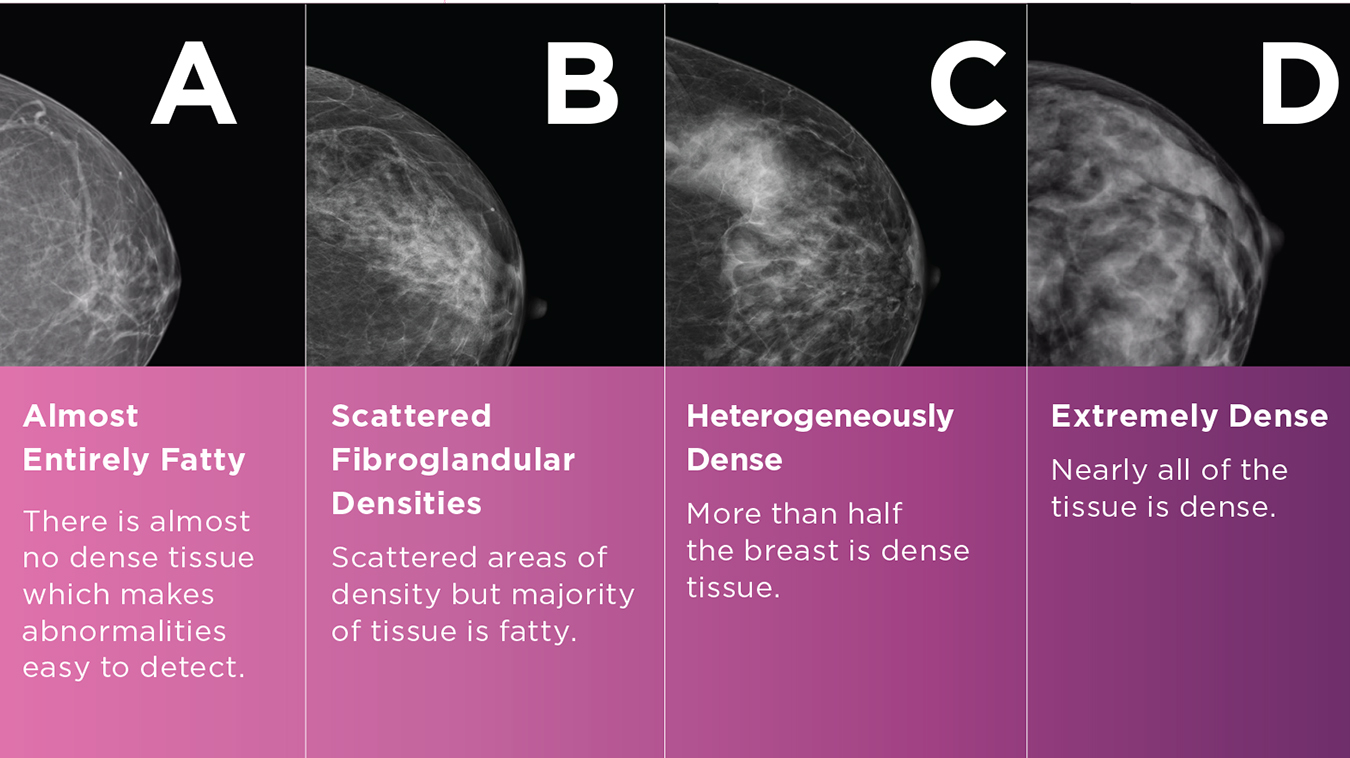TOLL FREE:
1-866-611-2665

Home WHAT ARE DENSE BREASTS?
Dense breast tissue is a risk factor for breast cancer. According to the Canadian Cancer Society, women with dense breast tissue have a higher risk of developing breast cancer than women with little or no dense breast tissue.
At Mayfair Diagnostics all of our mammogram machines use 3D mammography (tomosynthesis) and are equipped with software that classifies breast density, which is included in reports to referring doctors.
You can’t tell by looking at them, whether or not you have dense breasts. It is a clinical diagnosis that can only be assessed by mammography. Dense breasts have less fat and more glandular and connective tissue. Unfortunately, they also make a mammogram harder to read, so smaller cancers may be hidden. Plus, the denser the breast tissue, the higher the risk of breast cancer.
On a mammogram, fatty tissue looks dark, while both dense tissue and tumours look white, making it hard to distinguish between the two. The white-looking breast cancers are easier to see on a mammogram when they’re surrounded by dark-looking fatty tissue.
Dense breasts are normal. Your breast tissue changes as you age, usually becoming less dense as you get older and go through menopause, but some women continue to have dense breast regardless of age. Dense breasts may be affected by taking hormone replacement therapy.
To determine your breast density, you will need to discuss scheduling a mammogram and a review of the results with your health care provider.
The Breast Imaging Reporting and Database Systems, or BI-RADS, classifies breast density into four groups:
While scoring is not an exact science and radiologists often disagree about levels of density, it is important to get screened. Mayfair uses Volpara software, which scores density from A to D. We will also explain your breast score at the end of your appointment, if requested.
When an assessment determines that breast density is high, the radiologist may suggest annual mammography exams. In addition, the radiologist may suggest the use of handheld or automated breast ultrasound (ABUS) in conjunction with your regular screening mammogram.
Mammography views the breast in slices and provides a greater level of detail, while breast ultrasound increases the sensitivity of the scan. In Alberta, the Toward Optimized Practice Breast Cancer Screening Guidelines suggest that ultrasound “May be used as a supplemental tool by a radiologist after considering current and prior imaging (if available), and history.” You will need to discuss your results and next steps with your health care provider.
Mayfair has 13 mammography clinics in Calgary and one in Cochrane. We also have 13 ultrasound locations in Calgary and one in Cochrane, which offer breast ultrasound services. ABUS is offered at our Market Mall, Mayfair Place, Southcentre, and The CORE locations.
REFERENCES
Alberta Breast Cancer Screening Clinical Practice Guideline Committee (2022) “Alberta Breast Cancer Screening: Clinical Practice Guideline 2022 Update.” www.screeningforlife.ca. Accessed August 12, 2022.
Canadian Cancer Society (2022) “Breast density.” www.cancer.ca. Accessed September 1, 2022.
Canadian Cancer Society (2022) “Risks for breast cancer.” www.cancer.ca. Accessed September 1, 2022.
Łuczyńska, E., et al. (2022) “The Role of ABUS in The Diagnosis of Breast Cancer.” The Journal of Ultrasonography, 2022 Apr; 22(89): 76–85.
Mayo Clinic Staff (2022) “Dense breast tissue: What it means to have dense breasts.” www.mayoclinic.org. Accessed September 1, 2022.
Thigpen, D., et al. (2018) “The Role of Ultrasound in Screening Dense Breasts—A Review of the Literature and Practical Solutions for Implementation.” Diagnostics (Basel), 2018 Mar; 8(1): 20.
Our Refresh newsletter delivers the latest medical news, expert insights, and practical tips straight to your inbox, empowering you with knowledge to enhance patient care and stay informed.
By subscribing to our newsletter you understand and accept that we may share your information with vendors or other third parties who perform services on our behalf. The personal information collected may be stored, processed, and transferred to a country or region outside of Quebec.
Please read our privacy policy for more details.